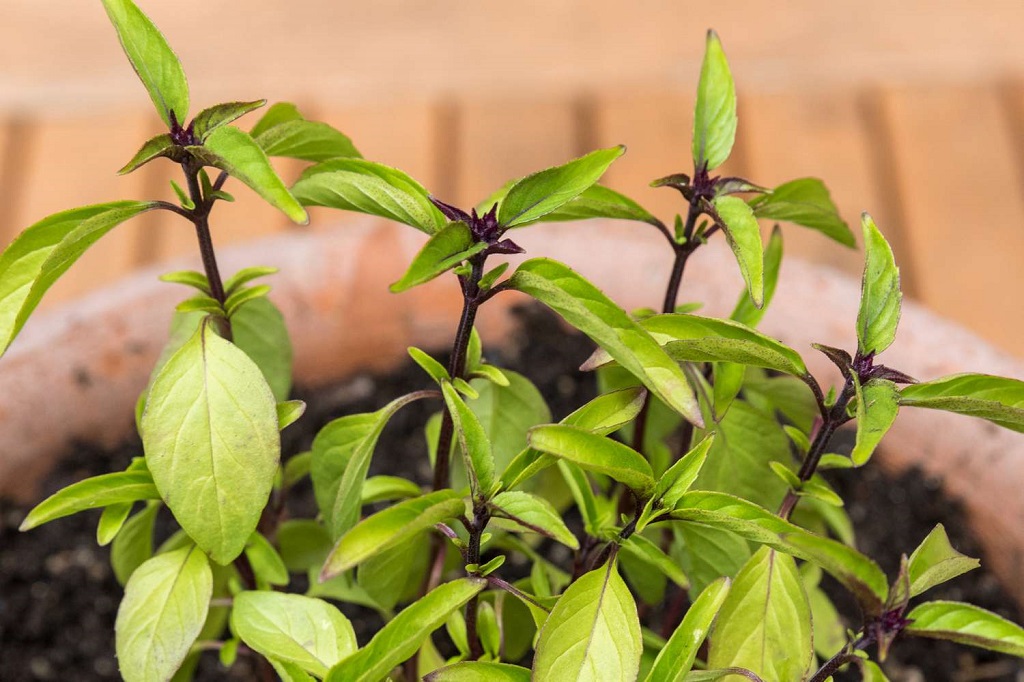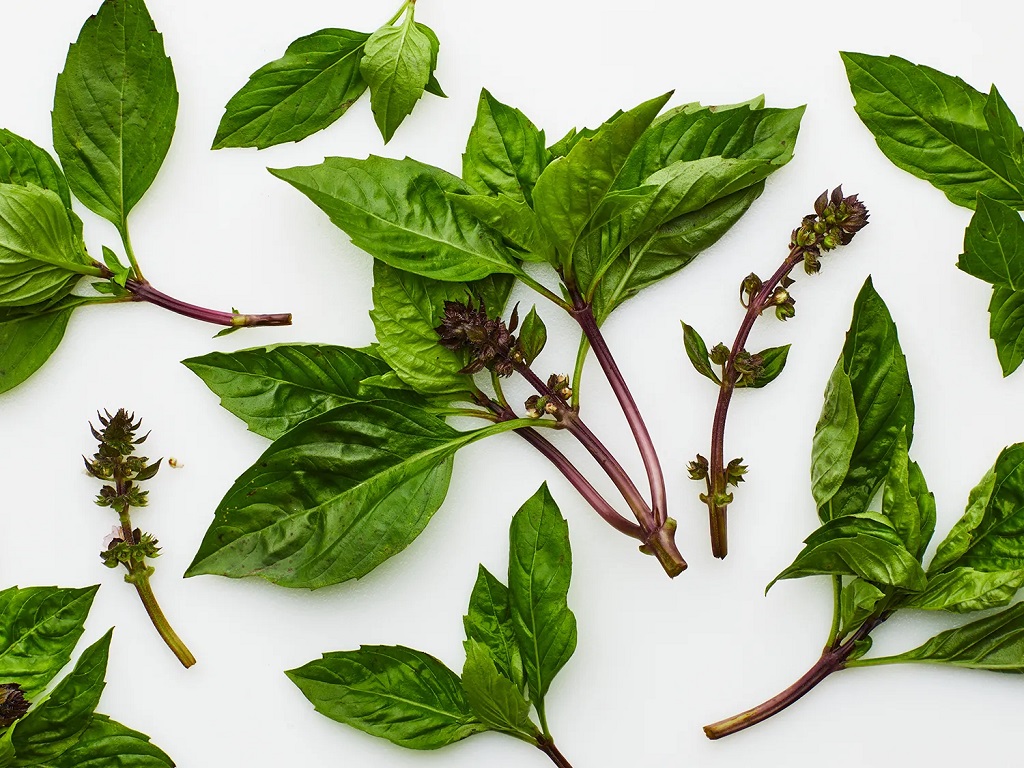Thai basil, with its distinctive licorice aroma and flavor, is a culinary powerhouse in Southeast Asian cuisine. But is it just a niche herb, or can it elevate your dishes beyond pad thai? This review dives deep into the world of Thai basil, exploring its uses, benefits, and potential drawbacks. Whether you’re a seasoned cook or a curious home chef, this guide will help you decide if Thai basil deserves a spot in your kitchen.
A Botanical Breakdown: Sweet vs. Holy
There’s often confusion between Thai basil and holy basil (sometimes called Thai holy basil). While both belong to the Lamiaceae (mint) family, they have distinct characteristics:
- Thai Basil (Ocimum basilicum var. thyrsiflora): This is the star of the show. It boasts elongated, pointed leaves with a deep purple stem and a strong licorice scent.
- Holy Basil (Ocimum tenuiflorum): This variety has smaller, slightly rounded leaves with a greenish hue and a more subtle clove-like aroma. It holds religious significance in some Southeast Asian cultures.
This review focuses on Thai basil, the one commonly used in Thai curries and stir-fries.
Flavor Profile: Licorice with a Twist
The dominant characteristic of Thai basil is its licorice aroma and taste. However, it’s not one-dimensional. Hints of anise and clove add complexity, while a subtle peppery bite lingers on the palate. This unique flavor profile makes it a perfect complement to savory dishes with strong umami notes, like fish sauce, shrimp paste, and coconut milk – staples of Thai cuisine.
Beyond Pad Thai: Culinary Versatility
Thai basil isn’t just for stir-fries! Here are some inspiring ways to incorporate this vibrant herb:
- Curries: Add Thai basil leaves near the end of cooking to infuse your curries (red, green, or yellow) with its distinctive flavor.
- Soups: Tom yum soup welcomes a touch of Thai basil for a refreshing, anise-tinged aroma.
- Salads: Thai basil adds a surprising and delicious twist to salads. Pair it with mango, papaya, or shrimp for an explosion of textures and flavors.
- Cocktails: Feeling adventurous? Muddle a few Thai basil leaves in your favorite mojito or gin and tonic for a unique herbal twist.
Pro Tip: Unlike sweet basil, Thai basil is best enjoyed fresh. Don’t cook it for extended periods, as it loses its aromatic qualities. Tear or chiffonade the leaves just before using to maximize their flavor impact.
Health Benefits: A Potential Powerhouse
While more research is needed, Thai basil holds promise for various health benefits due to its phytochemical content:
- Antioxidant Properties: Studies suggest it contains antioxidants like eugenol and anthocyanins, which may help combat free radical damage in the body.
- Antimicrobial Effects: Some evidence indicates Thai basil extracts exhibit antimicrobial activity, potentially aiding in preventing foodborne illnesses.
- Stress Reduction: The calming properties of the essential oil extracted from Thai basil are being explored for their potential role in stress management.
Important Note: These benefits are based on preliminary research and should not be taken as medical advice. Always consult a healthcare professional before using herbal remedies.
Potential Drawbacks: Not for Everyone
Despite its culinary and health benefits, Thai basil might not be for everyone:
- Strong Flavor: The pronounced licorice taste can be overpowering for some palates.
- Limited Availability: Fresh Thai basil might be harder to find than regular sweet basil, especially in smaller grocery stores.
- Substitutes: While substitutes like regular sweet basil or lemongrass exist, they won’t capture the unique character of Thai basil.
The Verdict: A Flavorful Friend with a Punch
So, does Thai basil “work”? Absolutely! If you’re looking for a flavorful herb to add a unique depth and complexity to your Southeast Asian-inspired dishes, Thai basil is a fantastic choice. However, be aware of its bold licorice flavor and potential limited availability.
Here’s a quick cheat sheet to help you decide:
- Love licorice? Go for Thai basil!
- Prefer milder flavors? Stick with sweet basil.
- Up for an adventure? Embrace the unique taste of Thai basil!
No matter your preference, Thai basil is a worthwhile exploration for curious cooks. With its captivating aroma and exciting flavor profile, it can add a touch of Southeast Asian magic to your culinary creations.

Expanding Your Thai Basil Horizons: Tips and Tricks
Now that you’re familiar with the basics of Thai basil, let’s delve deeper into some practical tips and tricks to elevate your cooking experience:
Selecting the Best Thai Basil:
- Freshness is Key: Look for vibrant purple stems and firm, unblemished leaves. Avoid wilted or discolored leaves.
- Aromatic Impact: Gently crush a leaf between your fingers. A strong licorice and anise scent signifies freshness.
- Season is Everything: Thai basil thrives in warm climates. Look for it at its peak during the summer months.
Storage and Preservation:
- Short-Term Storage: Wrap loosely in a damp paper towel and store in the refrigerator for up to a week. Change the damp paper towel daily to maintain freshness.
- Long-Term Storage: Freeze for extended storage. Wash and dry the leaves thoroughly. Flash-freeze them on a baking sheet for a few hours, then transfer them to airtight containers for up to 3 months.
Unlocking the Flavor:
- Chiffonade for Maximum Impact: Stack the leaves and roll them tightly into a cigar shape. Slice thinly across the roll to create a chiffonade, releasing the most concentrated flavor.
- Infuse Oils: Add a few Thai basil sprigs to olive oil or coconut oil while simmering for a subtle, long-lasting flavor infusion.
Growing Your Own:
- Warm and Sunny: Thai basil thrives in well-drained soil and a sunny location with at least 6 hours of direct sunlight daily.
- Regular Trimming: Pinch off flower buds to encourage bushier growth and maintain a steady supply of fresh leaves.
- Container Gardening: Thai basil is well-suited for container gardening. Choose a pot with drainage holes and use a good-quality potting mix.
Thai Basil Beyond the Plate:
- Potpourri: Dried Thai basil leaves add a unique and refreshing scent to potpourri blends.
- Natural Bug Repellent: The essential oil of Thai basil may help deter mosquitoes and other insects. However, more research is required to confirm its effectiveness.
Exploring Substitutes:
While not a perfect replacement, here are some options if Thai basil is unavailable:
- Sweet Basil: Offers a milder and sweeter flavor profile. Use a slightly larger quantity to compensate for the less intense aroma.
- Holy Basil: Has a distinct clove-like aroma and a slightly bitter taste.
- Lemongrass: Provides a citrusy note and works well in curries and stir-fries. However, it lacks the licorice and anise notes of Thai basil.
Related: Guy Fieri’s Healthy Food Habits
Experiment and Have Fun!
Thai basil is a versatile herb waiting to be explored. Don’t be afraid to experiment with different recipes and discover new ways to incorporate this unique flavor into your cooking. With its bold aroma and exciting taste, Thai basil can transform your dishes into a journey to Southeast Asia, right from your kitchen.




